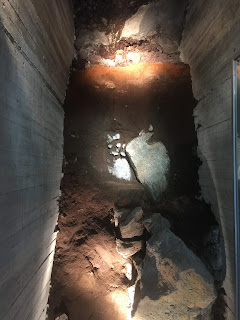We were welcomed upon arrival by Salvatore Spampinato, who was on the second day of his job as Hospitality Manager (I would not have known it was his second day except I asked how long he had been there as a prelude to complimenting him on his knowledge -- and skilled dissemination -- of the characteristics of the estate.). We were joined by Fabio Costantino, the owner, shorty after the start of the tour.
Terra Costantino is a 10-ha organic vineyard located in the Contrada Blandano area of the commune of Viagrande on the southeast flank of Mt. Etna. The estate is owned by the Costantino family and managed day-to-day by Fabio Costantino. Maps of the estate location are provided below.
 |
| High-level view of Terra Costantino location on Mt Etna |
 |
| More detailed view of Terra Costantino location |
Second, with no protective layer of mountains, the region bears the full brunt of the wind and rain coming in off the Ionian Sea. In the fall and spring, dry winds form over North Africa, pick up moisture over the Mediterranean, and barrel into the Sicilian coast at upwards of 50 miles an hour. These winds are called Scirocco and an event can last from 1/2 day to several days. The wind makes it easier to farm organically as it helps to keep mold at bay.
Third, the southeast is unprotected from the autumn and winter rains but the combination of rapid runoff and early morning sun contribute to its attractiveness as a growing region (especially for whites).
The vineyards are farmed organically and are planted to Nerello Mascalese, Nerello Cappuccio, Carricante, Minella, and Cataratta with 60% of the vines planted cordone speranato and the remaining Albarello. Rootstocks are Ruggieri and Paulson. Average vine age ranges between 15 and 35 years.
The farm is not a monoculture. Chestnut, olive, and cherry trees are planted all around the estate. Legumes are planted between the rows to aid in nitrogen fixing. An old-style palmento is also located on the estate.
 |
| Salvatore leading us into the Palmento |
Grapes are harvested based on sugar and acid levels as determined by tasting and analysis. There is a first selection in the vineyard followed by selection at a sorting table in the harvest reception area. In the cellar, cru reds are fermented in concrete tanks of varying dimensions and then aged in barrels. The top whites are fermented in barrels.
 |
| Brandon and Fabio just prior to us going into the tasting room |
The wines we tasted are shown below.
We started out with the 2016 deAetna Rosata, a 90/10 Nerello Mascalese/Nerello Cappuccio blend. This wine was subjected to 3 - 6 hours of skin contact after which it was processed like a white wine. It had a Provencal color and showed strawberries on the nose. Great acidity on the palate along with spice, minerality, and citrus rind. A sense of effervescence. A beautiful, powerful wine.
The second wine tasted was the 2015 deAetna Bianco DOC. The year 2015 was not well regarded because of excessive rainfall. This particular wine was 80% Carricante with the remainder divided between Catarratto and Minella. Stems, tree bark, and dried herbs on the nose. Grape fruit and salinity on the palate.
The 2014 deAetna Rosso DOC was 90% Nerello Mascalese from 35-year-old vines yielding 50 - 60 quintals/ha. This wine was fermented in stainless steel where it underwent malolactic fermentation and was aged for between 6 and 10 months. It was aged for an additional year in-bottle. Elegant. Coconut-oil character along with stemminess and bark. Would have preferred a little more structure. Mineral finish. Almost austere.
The 2013 Contrada Blandano is 80% Carricante. Some coconut oiliness, beautiful white peach, rosemary and dried herbs. A Semillon fatness. Salinity on palate and surprisingly low acidity. Could be more focused. Lime and lime rind.
Two consistent features that I noted in the wines of this estate was an oiliness, a feature that I found attractive, and a sapidity. I find the salinity in Carricante whites a pleasing characteristic but thought that it was excessive in the 2015. Not sure if and how much the excessive rain of the vintage played into that. As these vines age, and as the estate continues its work on ever-improving fruit quality, these wines will become even more distinctive over time.
©Wine -- Mise en abyme












No comments:
Post a Comment